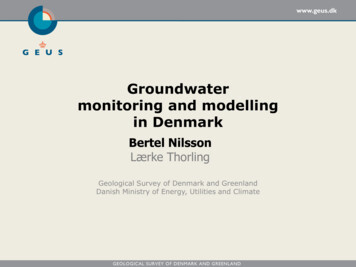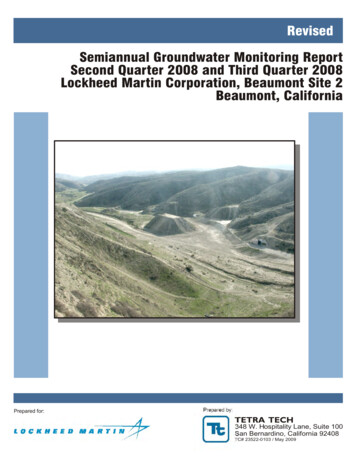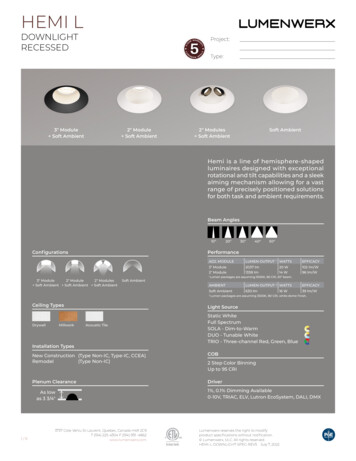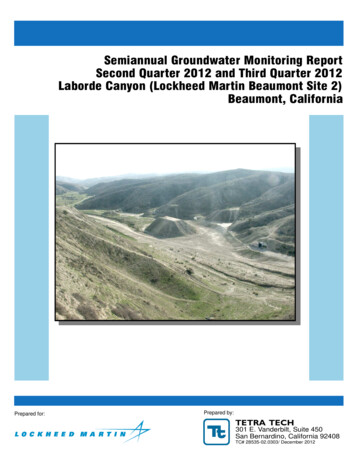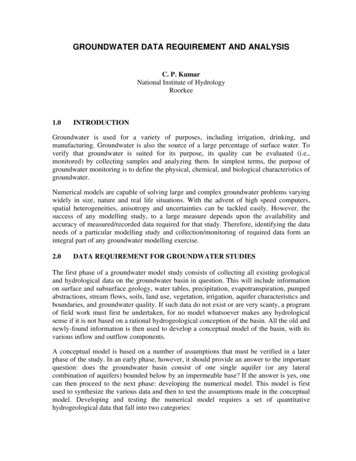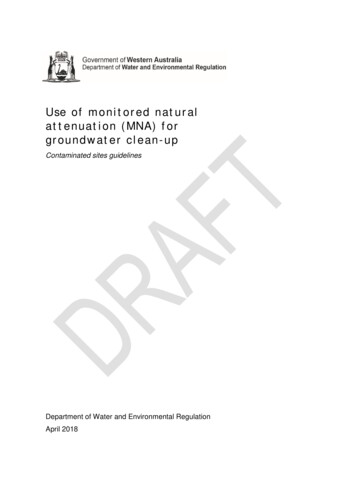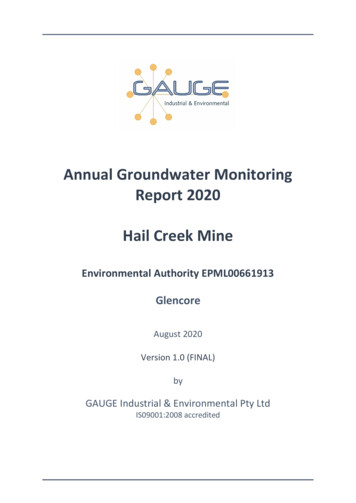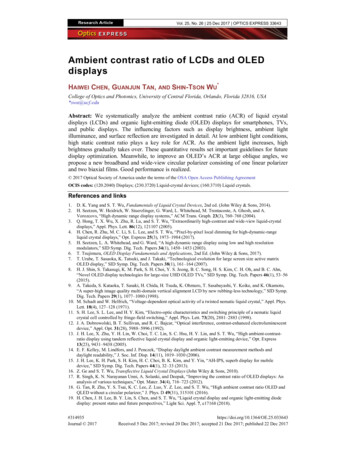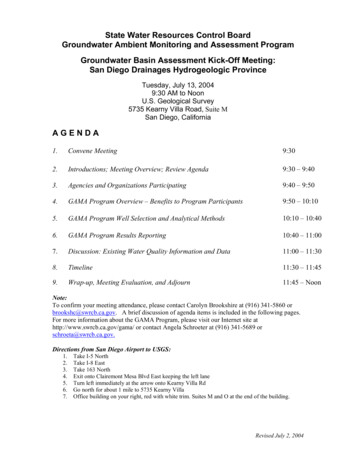
Transcription
State Water Resources Control BoardGroundwater Ambient Monitoring and Assessment ProgramGroundwater Basin Assessment Kick-Off Meeting:San Diego Drainages Hydrogeologic ProvinceTuesday, July 13, 20049:30 AM to NoonU.S. Geological Survey5735 Kearny Villa Road, Suite MSan Diego, CaliforniaAGENDA1.Convene Meeting9:302.Introductions; Meeting Overview; Review Agenda9:30 – 9:403.Agencies and Organizations Participating9:40 – 9:504.GAMA Program Overview – Benefits to Program Participants9:50 – 10:105.GAMA Program Well Selection and Analytical Methods10:10 – 10:406.GAMA Program Results Reporting10:40 – 11:007.Discussion: Existing Water Quality Information and Data11:00 – 11:308.Timeline11:30 – 11:459.Wrap-up, Meeting Evaluation, and Adjourn11:45 – NoonNote:To confirm your meeting attendance, please contact Carolyn Brookshire at (916) 341-5860 orbrookshc@swrcb.ca.gov. A brief discussion of agenda items is included in the following pages.For more information about the GAMA Program, please visit our Internet site athttp://www.swrcb.ca.gov/gama/ or contact Angela Schroeter at (916) 341-5689 orschroeta@swrcb.ca.gov.Directions from San Diego Airport to USGS:1.2.3.4.5.6.7.Take I-5 NorthTake I-8 EastTake 163 NorthExit onto Clairemont Mesa Blvd East keeping the left laneTurn left immediately at the arrow onto Kearny Villa RdGo north for about 1 mile to 5735 Kearny VillaOffice building on your right, red with white trim. Suites M and O at the end of the building.Revised July 2, 2004
State Water Resources Control BoardGroundwater Ambient Monitoring and Assessment ProgramGroundwater Basin Assessment Meeting:San Diego Drainages Hydrogeologic ProvinceAgenda Item Discussion1. Convene Meeting2. Meeting Overview3. Agencies and Organizations ParticipatingStewardship of the state’s groundwater resources is the shared responsibility of all levelsof the government and community. A key aspect of the Groundwater AmbientMonitoring and Assessment Program (GAMA) is interagency collaboration andcommunication with local water agencies. The intent is to include such agencies in localGroundwater Basin Assessment meetings and involve them in discussions about programimplementation. In general, participants will include representatives from State andRegional Water Boards (SWRCB/RWQCBs), Department of Water Resources (DWR),Department of Health Services (DHS), U.S. Geological Survey (USGS), LawrenceLivermore National Laboratory (LLNL), County, Local Water Purveyors, LocalGroundwater Management Authorities, and Regional Water Management Entities. Localparticipation in the GAMA Program is voluntary.The SWRCB is collaborating with the USGS and LLNL to implement the GAMAProgram. The USGS plays a key role in local agency coordination, well network designand the selection of target constituents, monitoring and assessment, and results reporting.Desired Outcome: Inclusion of relevant agencies and organizations in local GroundwaterBasin Assessment meetings.4. GAMA Program Overview – Benefits to Program ParticipantsThe primary objective of the GAMA Program is to comprehensively assess statewidegroundwater quality and gain an understanding about contamination risk to specificgroundwater resources. The Groundwater Quality Monitoring Act of 2001 (Sections10780-10782.3 of the Water Code) resulted in a publicly accepted plan to monitor andassess the quality of all priority groundwater basins that account for over 90% of allgroundwater used in the state. The plan builds on the existing GAMA Program andprioritizes groundwater basins for assessment based on groundwater use (reportsavailable at http://www.swrcb.ca.gov/gama/). Groundwater basin assessments areplanned across the state and represent areas in all 10 Hydrogeologic Provinces. Tofacilitate a statewide, comprehensive groundwater quality-monitoring and assessmentprogram most efficiently, uniform and consistent study-design and data-collectionprotocols are being applied to the entire state. Monitoring and assessments for prioritygroundwater basins are to be completed every ten years, with trend monitoring every 3Revised July 2, 2004
State Water Resources Control BoardGroundwater Ambient Monitoring and Assessment Programyears. To maximize interagency collaboration and communication with local agencies,Groundwater Basin Assessment coordination meetings will be held with appropriategovernment and community organizations.The GAMA Program provides several benefits to federal, state, local, and communityparticipants, a few key benefits are described below: Improves comprehensive statewide groundwater monitoring;Increases the availability of groundwater quality information to the public;Provides a mechanism to unite local, regional, and statewide groundwater programsin a common effort to understand and manage groundwater resources effectively;Facilitates interagency communication and data-sharing between federal, state, andneighboring local agencies;Improves understanding of local, regional, and statewide hydrogeology, as well asgroundwater quality issues and concerns;Provides groundwater data to establish baseline conditions and early warning ofpotential water quality concerns;Provides agencies with knowledge of groundwater trends and long term forecasting ingroundwater quality; which is important for groundwater management plan growthand preparation;Provides agencies with better information to respond to concerns of consumers andconsumer advocate groups;Helps inter-basin agencies that have basin-wide or regional groundwater managementobjectives; andCreates a database with access to groundwater quality data and provides tools to aidin completing groundwater assessments.Desired Outcome: Discuss GAMA Program goals and benefits to participatingstakeholders.5. GAMA Program Well Selection and Analytical MethodsGroundwater quality will be assessed in selected groundwater basins in the San DiegoDrainages Hydrogeologic Province, including Temecula, Warner Valley, SantaMargarita, San Luis Rey, and SweetwaterA total of 60 wells will be sampled in four study areas: 20 wells in the Temeculagroundwater basin, 10 in the Warner Valley groundwater basin, 20 wells collectively inthe Santa Margarita, San Luis Rey, Sweetwater, and other alluvial groundwater basins,and 10 wells in areas outside of mapped groundwater basins. The USGS will present thespecific well selection and analytical method approach used in the above groundwaterbasins.Revised July 2, 2004
State Water Resources Control BoardGroundwater Ambient Monitoring and Assessment ProgramIn general, the basic monitoring network utilizes an approach that selects wells that arespatially distributed across a study area, but that also incorporates an element ofrandomization in the selection process. To optimize data collection, the followingsampling density will be used as a guide for the GAMA Program:GAMA PROGRAM SAMPLING DENSITY Wells will be sampled at a density of one well per 25 square kilometers (9square miles).For basins less than 500 square kilometers (180 square miles), therecommended sampling density would provide fewer than 20 wells.However, to achieve statistically significant results, no fewer than 20 wellswill be sampled in any study area.For study area larger than 1500 square kilometers (540 square miles), therecommended sampling density would require sampling more than 60 wells.However, to maintain cost-effectiveness, no more than 60 wells will besampled in any study area.In general, a tiered analytical approach is being utilized to balance spatial coverage andanalytical intensity. In contrast to the public supply well monitoring required by DHS,the GAMA Program monitors a much broader suite of chemicals at much lower detectionlimits.The broadest spatial coverage, or first tier, will be provided by utilizing the existing DHSpublic supply well water quality database; these data can be used to characterize waterquality relative to beneficial use. The second tier will be provided by sampling a networkof wells for a “basic schedule” list of constituents (see Table 1). The basic schedule list ofconstituents are those used by the SWRCB for assessing the susceptibility of aquifers tocontamination, and include age-dating (tritium/helium-3 analyses provided by LLNL),stable isotopes, and low-level analyses of organic compounds. The third tier will samplefor a larger number of constituents, but at fewer wells than the second tier. The“expanded” list of constituents would include constituents covered by the USGS NationalWater Quality Assessment Program (NAWQA), as well as emergent contaminants (suchas wastewater constituents and pharmaceutical products) (see Table 2).Desired Outcome: Discuss well selection and analytical approach used in the San DiegoDrainages Hydrogeologic Province.Revised July 2, 2004
State Water Resources Control BoardGroundwater Ambient Monitoring and Assessment ProgramTable 1. Chemical analysis, basic schedule (Tier II)SCHEDULECONSTITUENTSVolatile Organic Compounds (VOC), USGSNational Water Quality Assessment Program(NAWQA)20204024Methyl-tert Butyl Ether (MTBE ), NAWQA2003Pesticides, NAWQA4200lab filter pesticide sample1142Deuterium (D) , Oxygen-18 (O-18)1565Tritium, USGS (also Tritium/Helium-3 by LLNL)Conductance SampleWater TemperatureOther constituents, as appropriateNotes:Schedule 2020 includes VOCs included in GAMA.Schedule 4024 includes very low level MTBEOther constituents include “emerging contaminants” such as perchlorate, pharmaceutical products,NDMA, 1-4 dioxane, chromium (total and VI).Table 2. Chemical analysis, expanded schedule (Tier 42156513691263ColiphageE-ColiCONSTITUENTSMajor InorganicsTrace ElementsNutrients, NAWQADissolved Organic Carbon (DOC), NAWQAVOC, NAWQAMTBE , NAWQAPesticides, NAWQALab Filter Pesticide SampleWastewater, NAWQAD, O-18Tritium, USGSRadonRadium Gross alpha/beta or 1262Perchlorate And Other Constituents, as appropriateColiphageE-ColiField ParametersNotes: Field parameters include: conductance, temperature, dissolved oxygen, alkalinity, pH.Other constituents include “emerging contaminants” such as pharmaceutical products, Nnitrosodimethylamine (NDMA), 1-4 dioxane, chromium (total and VI).Revised July 2, 2004
State Water Resources Control BoardGroundwater Ambient Monitoring and Assessment Program6. GAMA Program Results ReportingThe GAMA Program is committed to facilitating interagency communication and datasharing. However, the program is also sensitive to the needs of local water agencies inreporting water quality data.Preliminary results will be discussed with participants at the local Groundwater BasinAssessment “Wrap-Up” meetings. In addition, once approved, the GAMA data will beprovided to the relevant local water agencies. The SWRCB and USGS will post asummary data report on the program Internet site, to be followed by the GroundwaterBasin Assessment report. Prior to publicly posting any data to the Internet, the SWRCBand USGS will work closely with the local water agencies to ensure that the GAMA datais communicated in a manner, which is acceptable to all stakeholders. Local wateragencies will be notified prior to public release of any data and reports and additionaltechnical presentations are available, if desired.The SWRCB is also working to include the GAMA data in a centralized, internetaccessible database (currently Geotracker). This database will be accessible to programparticipants via password protection using appropriate security and screening measures.The goal is to provide access to groundwater quality related data including existinggroundwater water quality data – i.e. DHS public supply well data, GAMA data, and datarelevant to potentially contaminating activities, so that the data may be collectivelyanalyzed to adequately assess groundwater quality and make determinations about threatsto groundwater resources.Desired Outcome: Discuss the reporting of GAMA Program results.7. Existing Water Quality Information and DataAn important aspect of the GAMA Program is to maximize the use of existinggroundwater data and information. Augmented with additional groundwater monitoring,existing data (such as the DHS public supply well water quality data) will be used tocomplete the groundwater basin assessments.The USGS has extensive knowledge of regional and local hydrogeology and waterquality. Additionally, the GAMA Program requests that participants help to identifyexisting data and information on local groundwater resources, covering such topics as:Revised July 2, 2004
State Water Resources Control BoardGroundwater Ambient Monitoring and Assessment ProgramExisting Groundwater Data IdentificationKey Groundwater Studies Local, Basin, or Regional Scale Hydrogeologic Studies Water Quality Water Use/Management OtherWell Construction/Locational Data Public Supply Wells Domestic Wells Monitoring Wells Abandoned Wells OtherGroundwater Quality Data Public Supply Wells (coordinatingwith DHS) Domestic Wells Monitoring Wells OtherWater Quality Issues/Concerns Known local, basin-wide, or regionalgroundwater issues/concerns Key contamination issues (potentiallycontaminating activities, contaminantplumes, chemicals of concern, etc.) Special hydrogeologic conditions OtherDesired Outcome: Identification of existing groundwater quality information and datafor the San Diego Drainages Hydrogeologic Province.8. TimelineThe USGS will present the specific timeframe for sampling, analysis and reporting. Inaddition, participants will schedule a date for the San Diego Drainages HydrogeologicProvinces “Wrap-Up Meeting” to discuss groundwater basin assessment status andpreliminary results.9. Wrap-up, Meeting Evaluation, and AdjournRevised July 2, 2004
Groundwater Basin Assessment coordination meetings will be held with appropriate government and community organizations. The GAMA Program provides several benefits to federal, state, local, and community participants, a few key benefits are described below: Improves comprehensive statewide groundwater monitoring;
